|
|

Product Number: UBR-ODD-XXX
This document explains how to remove and replace the duplexer component of the multipoint wireless transverter in the Cisco broadband fixed wireless multipoint headend system. The document includes instructions for powering down the transverter, removing an installed duplexer, installing a new duplexer, and reinstating the power to the transverter.
 |
Note Use this document in conjunction with the Cisco uBR7200 Series Universal Broadband Router Hardware Installation Guide and Cisco uBR7200 Series Universal Broadband Router Software Configuration Guide, both of which shipped with your Cisco uBR7200 series router, and the Cisco uBR7200 Series Multipoint Wireless Modem Card and Subsystem Installation document that shipped with your multipoint wireless modem card. |
This document includes the following sections:
The Cisco IOS software running on your router contains extensive features and functionality. The effective use of many of these features is easier if you have more information. For additional information on configuring and maintaining the Cisco uBR7200 series router, the following documentation resources are available:
 |
Note You can access Cisco IOS software configuration documentation on the World Wide Web at http://www.cisco.com, http://www-china.cisco.com, http://www-europe.cisco.com. |
The duplexer (see Figure 1) acts as an isolation filter and separates the transmitted (Tx) signals from the received (Rx) signals.
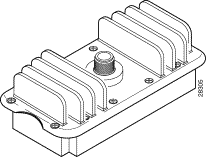
The duplexer assembly is an integral part of the wireless transverter and has an N-type, female, weatherized connector for attaching the antenna cable (see Figure 2).
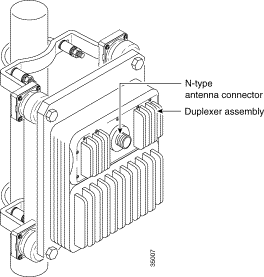
The duplexer is shipped as a separate unit. The duplexer you receive is based on the RF channel plan you have selected for your installation.
This section provides a list of parts and tools that you need to remove and replace the duplexer in the wireless transverter. This section also includes safety and ESD-prevention guidelines to help you avoid injury to yourself or damage to the equipment.
To remove and replace the duplexer assembly, you need the following tools and parts. If you need additional equipment, contact a service representative for ordering information.
 |
Note Some N-type connectors require specific tools. Obtain this information from your cable vendor. |
 |
Note If the optional hail shields have been installed, remove them first. Refer to the instructions that shipped with the shields. |
The following are safety guidelines that you should observe when working with any equipment that connects to electrical power or telephone wiring.
| |||
Waarschuwing | Dit waarschuwingssymbool betekent gevaar. U verkeert in een situatie die lichamelijk letsel kan veroorzaken. Voordat u aan enige apparatuur gaat werken, dient u zich bewust te zijn van de bij elektrische schakelingen betrokken risico's en dient u op de hoogte te zijn van standaard maatregelen om ongelukken te voorkomen. Voor vertalingen van de waarschuwingen die in deze publicatie verschijnen, kunt u het gedeelte "Translated Safety Warnings" (Vertalingen van veiligheidsvoorschriften) raadplegen in dit document. | ||
Varoitus | Tämä varoitusmerkki merkitsee vaaraa. Olet tilanteessa, joka voi johtaa ruumiinvammaan. Ennen kuin työskentelet minkään laitteiston parissa, ota selvää sähkökytkentöihin liittyvistä vaaroista ja tavanomaisista onnettomuuksien ehkäisykeinoista. Tässä julkaisussa esiintyvien varoitusten käännökset löydät tämän asiakirjan "Translated Safety Warnings" (käännetyt turvallisuutta koskevat varoitukset). | ||
Attention | Ce symbole d'avertissement indique un danger. Vous vous trouvez dans une situation pouvant causer des blessures ou des dommages corporels. Avant de travailler sur un équipement, soyez conscient des dangers posés par les circuits électriques et familiarisez-vous avec les procédures couramment utilisées pour éviter les accidents. Pour prendre connaissance des traductions d'avertissements figurant dans cette publication, consultez la section « Translated Safety Warnings » (Traduction des avis de sécurité) de ce document. | ||
Warnung | Dieses Warnsymbol bedeutet Gefahr. Sie befinden sich in einer Situation, die zu einer Körperverletzung führen könnte. Bevor Sie mit der Arbeit an irgendeinem Gerät beginnen, seien Sie sich der mit elektrischen Stromkreisen verbundenen Gefahren und der Standardpraktiken zur Vermeidung von Unfällen bewußt. Übersetzungen der in dieser Veröffentlichung enthaltenen Warnhinweise finden Sie im Abschnitt "Translated Safety Warnings" (Übersetzung der Warnhinweise) in diesem Dokument. | ||
Avvertenza | Questo simbolo di avvertenza indica un pericolo. La situazione potrebbe causare infortuni alle persone. Prima di lavorare su qualsiasi apparecchiatura, occorre conoscere i pericoli relativi ai circuiti elettrici ed essere al corrente delle pratiche standard per la prevenzione di incidenti. La traduzione delle avvertenze riportate in questa pubblicazione si trova nella documento "Translated Safety Warnings" (Traduzione delle avvertenze di sicurezza) nel presente documento. | ||
Advarsel | Dette varselsymbolet betyr fare. Du befinner deg i en situasjon som kan føre til personskade. Før du utfører arbeid på utstyr, må du vare oppmerksom på de faremomentene som elektriske kretser innebærer, samt gjøre deg kjent med vanlig praksis når det gjelder å unngå ulykker. Hvis du vil se oversettelser av de advarslene som finnes i denne publikasjonen, kan du se i avsnittet "Translated Safety Warnings" [Oversatte sikkerhetsadvarsler] i dette dokumentet. | ||
Aviso | Este símbolo de aviso indica perigo. Encontra-se numa situação que lhe poderá causar danos físicos. Antes de começar a trabalhar com qualquer equipamento, familiarize-se com os perigos relacionados com circuitos eléctricos, e com quaisquer práticas comuns que possam prevenir possíveis acidentes. Para ver as traduções dos avisos que constam desta publicação, consulte a secção "Translated Safety Warnings" - "Traduções dos Avisos de Segurança" neste documento. | ||
¡Advertencia! | Este símbolo de aviso significa peligro. Existe riesgo para su integridad física. Antes de manipular cualquier equipo, considerar los riesgos que entraña la corriente eléctrica y familiarizarse con los procedimientos estándar de prevención de accidentes. Para ver una traducción de las advertencias que aparecen en esta publicación, consultar la sección titulada "Translated Safety Warnings" que aparece en este documento. | ||
Varning! | Denna varningssymbol signalerar fara. Du befinner dig i en situation som kan leda till personskada. Innan du utför arbete på någon utrustning måste du vara medveten om farorna med elkretsar och känna till vanligt förfarande för att förebygga skador. Om du vill se översättningar av de varningar som visas i denna publikation, se avsnittet "Translated Safety Warnings" [Översatta säkerhetsvarningar] i detta dokument. | ||
Follow these basic guidelines when working with any electrical equipment.
Use the following procedures to remove and replace the duplexer in a wireless transverter.
 |
Note You can remove and replace the duplexer without removing the transverter from the antenna mast. |
 |
Warning Only trained and qualified personnel should be allowed to install, replace, or service this equipment. This equipment contains an energy hazard. Disconnect the system before servicing. To see translations of the warnings that appear in this publication, refer to the "Translated Safety Warnings" section of this document. |
 |
Warning Do not work on the system or connect or disconnect cables during periods of lightning activity. To see translations of the warnings that appear in this publication, refer to the "Translated Safety Warnings" section of this document. |
To remove an installed duplexer from a wireless transverter, complete the following procedures:
1. Shutting Down the Wireless Link
4. Removing the Duplexer from the Transverter
 |
Note If the duplexer will be replaced in the wireless transverter before the transverter is installed on the antenna mast and power is applied to the system, proceed to the "Removing the Duplexer from the Transverter" section. |
The duplexer should be removed only when the transverter is not transmitting a signal. Use the procedures established at your installation and the shut command to shut down the appropriate sector in the wireless link.
To disconnect the DC power from the individual transverter, complete the following steps:

Step 2 Tape the power/breaker switch for the transverter in the OFF position.
 |
Warning Before performing any of the following procedures, ensure that DC power to the transverter you will be working on is turned OFF. To ensure that the power to the specific transverter is OFF, locate the power/breaker switch on the front of power feed panel that services that transverter, push the switch into the OFF position, then tape the switch in the OFF position. To see translations of the warnings that appear in this publication, refer to the "Translated Safety Warnings" section of this document. |
Remove the antenna cable from the N-type connector on the duplexer (see Figure 4).
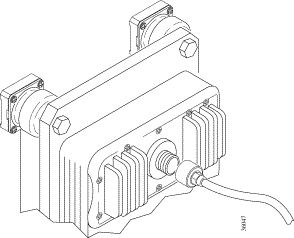
To remove the duplexer from the transverter, complete the following steps:
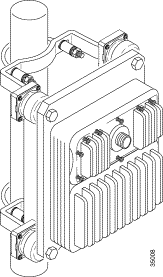
Step 2 Remove the duplexer assembly (see Figure 6), and set it aside, being careful not to damage the internal RF connectors.
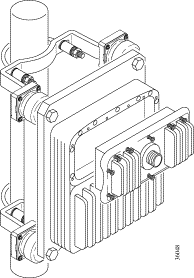
To replace the duplexer, complete the following procedures:
Make sure that you install the replacement duplexer in the correct orientation. When it is installed in the transverter, the orientation of the duplexer determines its transmit and receive frequencies for that transverter sector.
 |
Note The choice of Tx Hi or Rx Hi must match the frequencies configured for the multipoint wireless modem card using the command-line interface or CiscoView. |
To install the duplexer in the transverter, complete the following steps:
Step 2 Detach the bottom portion of the label affixed to the underside of the duplexer (see Figure 7) and record the duplexer orientation. This label can be attached to equipment records and used for reference when configuring the system or performing maintenance.

Step 3 Depending on whether that sector is transmitting or receiving on the high-frequency band, match the notched end of the duplexer with either the Tx Hi or Rx Hi side of the duplexer receptacle in the transverter (see Figure 8).

Step 4 Verify that the gasket is aligned in the groove in the transverter chassis (see Figure 9).

Step 5 Carefully line up the duplexer and plug it into the chassis, being careful that the internal RF connectors are properly aligned.
Step 6 Verify that the cover of the duplexer housing is flush with the transverter housing.
 |
Caution If the cover is not flush, check the alignment of the internal RF connectors. In order to avoid damage, never tighten the captive screws until the cover is flush. |
Step 7 Using the torque driver with the number 2 Phillips bit, follow the numeric sequence in Figure 10, and lightly seat the screws.
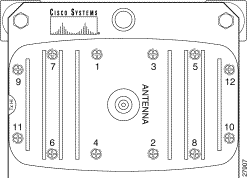
Step 8 Repeat the sequence in Figure 10, tightening the screws to between 16 and 20 inch-pounds of torque.
 |
Note If you removed the transverter from the mast before replacing the duplexer, the remaining steps do not apply. To install the multipoint wireless transverter on an antenna mast, refer to the instructions shipped with the transverter or to the Cisco uBR7200 Series Multipoint Wireless Modem Card and Subsystem Installation document that shipped with your multipoint wireless modem card. |
Connect the antenna cable to the N-type connector on the duplexer (see Figure 11).

 |
Note After connecting, apply cable-connector weatherproofing to the antenna cable connection. |
To reinstate the power, complete the following steps:
Step 2 Reinstate power by moving the power/breaker switch to the ON position (see Figure 12).

To reinstate the wireless link, complete the following steps:
 |
Note Entering the insertion loss parameter is optional. If this parameter is omitted, the value 1dB will be assumed. |
Step 2 Using the procedures established at your installation, reinstate the wireless link with the no shut command.
This completes the procedure for removing and replacing the duplexer in a Cisco broadband fixed wireless multipoint system headend wireless transverter.
This section provides translations of the warnings found in this document.
| |||
Waarschuwing | Alleen getraind en gekwalificeerd personeel mag deze uitrusting installeren, vervangen of onderhouden. Deze uitrusting bevat energierisico's. Ontkoppel het systeem voordat u het onderhoudt. | ||
Varoitus | Tämän laitteen asennuksen, vaihdon tai huollon saa suorittaa ainoastaan koulutettu ja pätevä henkilökunta. Laitteessa on sähköiskuvaara. Irrota järjestelmä ennen huoltoa. | ||
Attention | Cet équipement ne doit être installé, remplacé ou entretenu que par du personnel d'entretien qualifié et formé. Cet équipement contient de l'énergie électrique potentiellement dangereuse. Débrancher le système avant tout entretien/révision. | ||
Warnung | Gerät nur von geschultem, qualifiziertem Personal installieren, auswechseln oder warten lassen. Im Gerät liegt gefährliche Spannung an. Vor allen Wartungsarbeiten Gerät vom Netz trennen. | ||
Avvertenza | Questo apparato può essere installato, sostituito o revisionato solo da personale qualificato e competente. Questo apparecchio presenta pericolo di scosse elettriche. Scollegare il sistema prima di procedere alla revisione. | ||
Advarsel | Dette utstyret skal bare monteres, skiftes ut eller vedlikeholdes av kvalifisert personell som har gjennomgått opplæring. Det kan være fare for elektrisk støt forbundet med dette utstyret. Kople fra systemet før igangsetting av vedlikeholdsarbeid. | ||
Aviso | Apenas pessoal treinado e qualificado deve ser autorizado a instalar, substituir ou fazer a revisão deste equipamento. Este equipamento constitui risco de choque eléctrico. Desligar o sistema antes de efectuar qualquer serviço de revisão. | ||
¡Advertencia! | Solamente el personal calificado debe instalar, reemplazar o reparar este equipo, ya que existe riesgo de descarga eléctrica. Desenchufe el sistema antes de proceder al mantenimiento del mismo. | ||
Varning! | Endast utbildad och behörig personal får utföra installation, utbyte eller service av denna utrustning. Denna utrustning kan medföra fara för elstöt. Koppla ifrån systemet innan service utförs. | ||
| |||
Waarschuwing | Tijdens onweer dat gepaard gaat met bliksem, dient u niet aan het systeem te werken of kabels aan te sluiten of te ontkoppelen. | ||
Varoitus | Älä työskentele järjestelmän parissa äläkä yhdistä tai irrota kaapeleita ukkosilmalla. | ||
Attention | Ne pas travailler sur le système ni brancher ou débrancher les câbles pendant un orage. | ||
Warnung | Arbeiten Sie nicht am System und schließen Sie keine Kabel an bzw. trennen Sie keine ab, wenn es gewittert. | ||
Avvertenza | Non lavorare sul sistema o collegare oppure scollegare i cavi durante un temporale con fulmini. | ||
Advarsel | Utfør aldri arbeid på systemet, eller koble kabler til eller fra systemet når det tordner eller lyner. | ||
Aviso | Não trabalhe no sistema ou ligue e desligue cabos durante períodos de mau tempo (trovoada). | ||
¡Advertencia! | No operar el sistema ni conectar o desconectar cables durante el transcurso de descargas eléctricas en la atmósfera. | ||
Varning! | Vid åska skall du aldrig utföra arbete på systemet eller ansluta eller koppla loss kablar. | ||
| |||
Waarschuwing | Voordat u een van de onderstaande procedures uitvoert, dient u te controleren of de stroom op het gelijkstroomcircuit is uitgeschakeld. Om u ervan te verzekeren dat alle stroom is UITgeschakeld, kiest u op het schakelbord de stroomverbreker die het gelijkstroom circuit bedient, draait u de stroomverbreker naar de UIT positie en plakt u de schakelaarhendel van de stroomverbreker met plakband in de UIT positie vast. | ||
Varoitus | Varmista ennen seuraavien toimenpiteiden suorittamista, että tasavirtapiirin virta on KATKAISTU. Varmistaaksesi, että virta on KATKAISTU täysin, paikanna tasavirrasta huolehtivassa kojetaulussa sijaitseva suojakytkin. Käännä suojakytkin KATKAISTU-asentoon. Teippaa suojakytkimen varsi niin, että kytkin pysyy KATKAISTU-asennossa. | ||
Attention | Avant d'effectuer l'une des procédures décrites ci-dessous, vérifiez que le circuit alimenté en courant continu n'est plus sous tension. Pour vous en assurer, localisez le disjoncteur situé sur le panneau de service du circuit en courant continu, désactivez-le (OFF) et, à l'aide d'un ruban adhésif, bloquez la poignée du disjoncteur en position OFF. | ||
Warnung | Vor Ausführung der folgenden Vorgänge ist sicherzustellen, daß der Transverter, mit dem Sie arbeiten, nicht mit Strom versorgt wird. Um sicherzustellen, daß der Strom abgestellt ist, machen Sie auf der Vorderseite der Schalttafel den Stromschalter für den Transverter ausfindig, stellen Sie den Schalter auf AUS, und kleben Sie den Schaltergriff mit Klebeband in der AUS-Stellung fest. | ||
Avvertenza | Prima di svolgere una qualsiasi delle procedure seguenti, verificare che il circuito in corrente continua non sia alimentato. Per verificare che tutta l'alimentazione sia scollegata (OFF), individuare l'interruttore automatico sul quadro strumenti che alimenta il circuito CC, mettere l'interruttore in posizione OFF e fissarlo con nastro adesivo in tale posizione. | ||
Advarsel | Før du utfører noen av disse prosedyrene, må du kontrollere at strømtilførselen til transformatoren du skal bruke, er slått AV. Dette gjøres ved å lokalisere strømbryteren foran på brytertavlen som betjener transformatoren, deretter trykker du bryteren inn i AV-stilling og fester bryteren med teip i AV-stilling. | ||
Aviso | Antes de executar qualquer um dos seguintes procedimentos, certifique-se de que a fonte de alimentação de corrente contínua para o transversor em que irá trabalhar está DESLIGADA. Para se certificar de que toda a alimentação para esse transversor foi DESLIGADA, localize o disjuntor no painel que alimenta esse transversor e coloque-o na posição OFF (Desligado) e, em seguida, segure o disjuntor nessa posição com fita isoladora. | ||
¡Advertencia! | Antes de proceder con los siguientes pasos, comprobar que la alimentación del circuito de corriente continua (CC) con el que se va a trabajar esté cortada (OFF). Para ello, localizar el interruptor de corriente en la parte frontal del panel que alimenta al circuito, cambiar el interruptor automático a la posición de Apagado (OFF) y sujetar con cinta adhesiva la palanca del interruptor automático en posición de Apagado (OFF). | ||
Varning! | Innan du utför någon av följande procedurer måste du kontrollera att strömförsörjningen till likströmskretsen är bruten. Kontrollera att all strömförsörjning är BRUTEN genom att slå AV det överspänningsskydd som skyddar likströmskretsen och tejpa fast överspänningsskyddets omkopplare i FRÅN-läget. | ||
The following sections provide sources for obtaining documentation from Cisco Systems.
You can access the most current Cisco documentation on the World Wide Web at the following sites:
Cisco documentation and additional literature are available in a CD-ROM package, which ships with your product. The Documentation CD-ROM is updated monthly and may be more current than printed documentation. The CD-ROM package is available as a single unit or as an annual subscription.
Cisco documentation is available in the following ways:
If you are reading Cisco product documentation on the World Wide Web, you can submit technical comments electronically. Click Feedback in the toolbar and select Documentation. After you complete the form, click Submit to send it to Cisco.
You can e-mail your comments to bug-doc@cisco.com.
To submit your comments by mail, for your convenience many documents contain a response card behind the front cover. Otherwise, you can mail your comments to the following address:
Cisco Systems, Inc.
Document Resource Connection
170 West Tasman Drive
San Jose, CA 95134-9883
We appreciate your comments.
Cisco provides Cisco.com as a starting point for all technical assistance. Customers and partners can obtain documentation, troubleshooting tips, and sample configurations from online tools. For Cisco.com registered users, additional troubleshooting tools are available from the TAC website.
Cisco.com is the foundation of a suite of interactive, networked services that provides immediate, open access to Cisco information and resources at anytime, from anywhere in the world. This highly integrated Internet application is a powerful, easy-to-use tool for doing business with Cisco.
Cisco.com provides a broad range of features and services to help customers and partners streamline business processes and improve productivity. Through Cisco.com, you can find information about Cisco and our networking solutions, services, and programs. In addition, you can resolve technical issues with online technical support, download and test software packages, and order Cisco learning materials and merchandise. Valuable online skill assessment, training, and certification programs are also available.
Customers and partners can self-register on Cisco.com to obtain additional personalized information and services. Registered users can order products, check on the status of an order, access technical support, and view benefits specific to their relationships with Cisco.
To access Cisco.com, go to the following website:
The Cisco TAC website is available to all customers who need technical assistance with a Cisco product or technology that is under warranty or covered by a maintenance contract.
If you have a priority level 3 (P3) or priority level 4 (P4) problem, contact TAC by going to the TAC website:
P3 and P4 level problems are defined as follows:
In each of the above cases, use the Cisco TAC website to quickly find answers to your questions.
To register for Cisco.com, go to the following website:
http://www.cisco.com/register/
If you cannot resolve your technical issue by using the TAC online resources, Cisco.com registered users can open a case online by using the TAC Case Open tool at the following website:
http://www.cisco.com/tac/caseopen
If you have a priority level 1(P1) or priority level 2 (P2) problem, contact TAC by telephone and immediately open a case. To obtain a directory of toll-free numbers for your country, go to the following website:
http://www.cisco.com/warp/public/687/Directory/DirTAC.shtml
P1 and P2 level problems are defined as follows:

![]()
![]()
![]()
![]()
![]()
![]()
![]()
![]()
Posted: Fri Jun 8 12:26:57 PDT 2001
All contents are Copyright © 1992--2001 Cisco Systems, Inc. All rights reserved.
Important Notices and Privacy Statement.